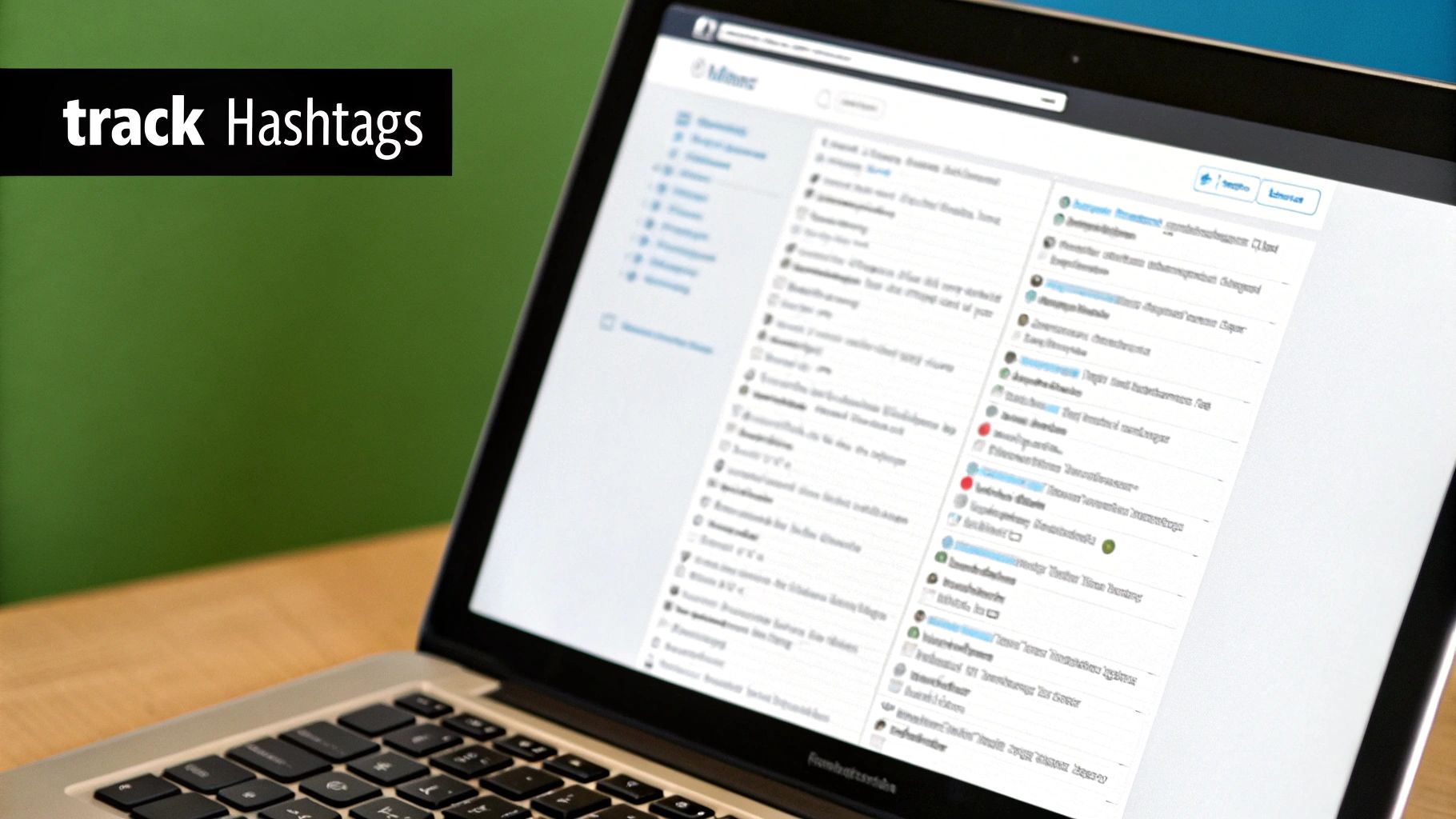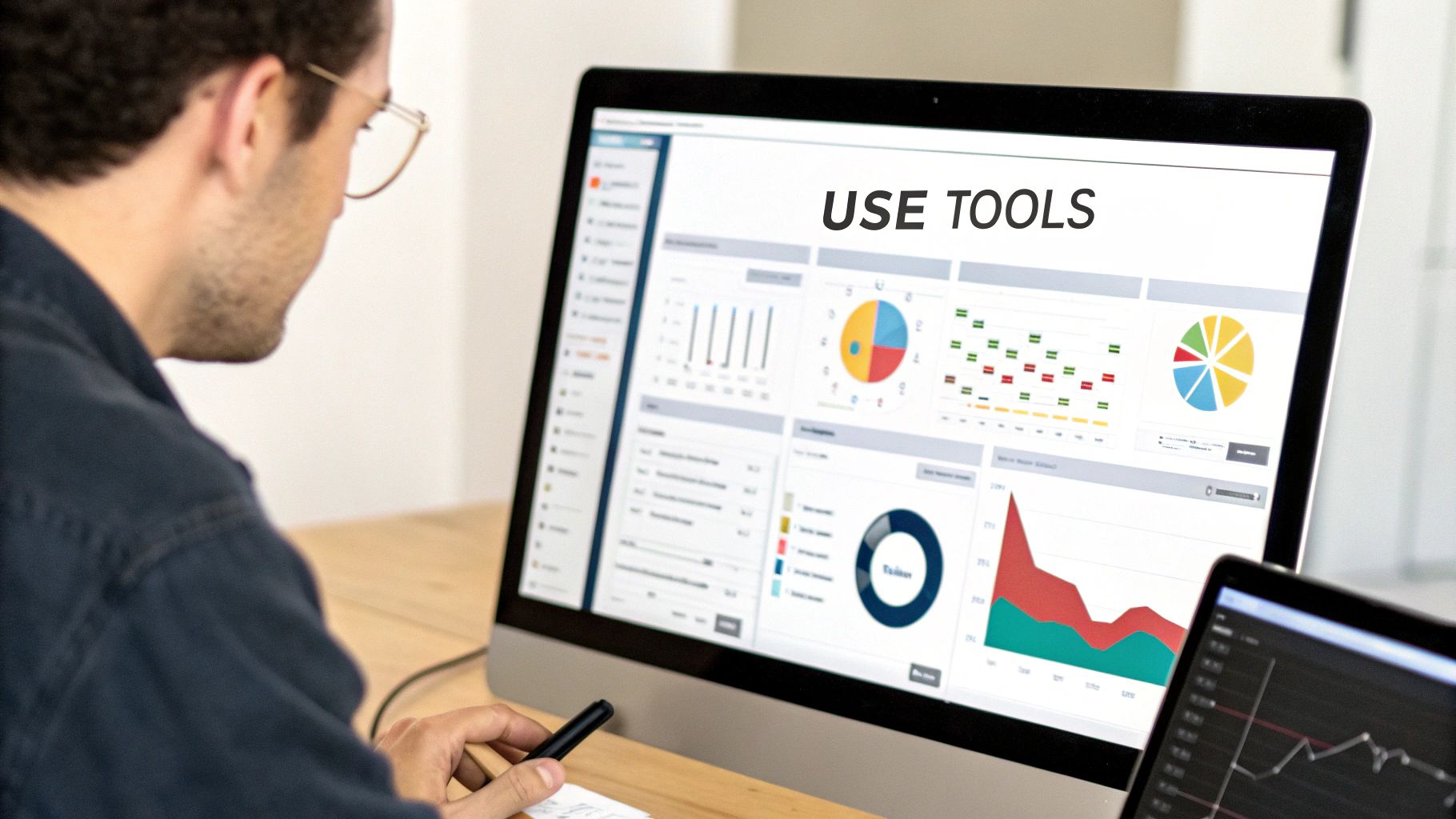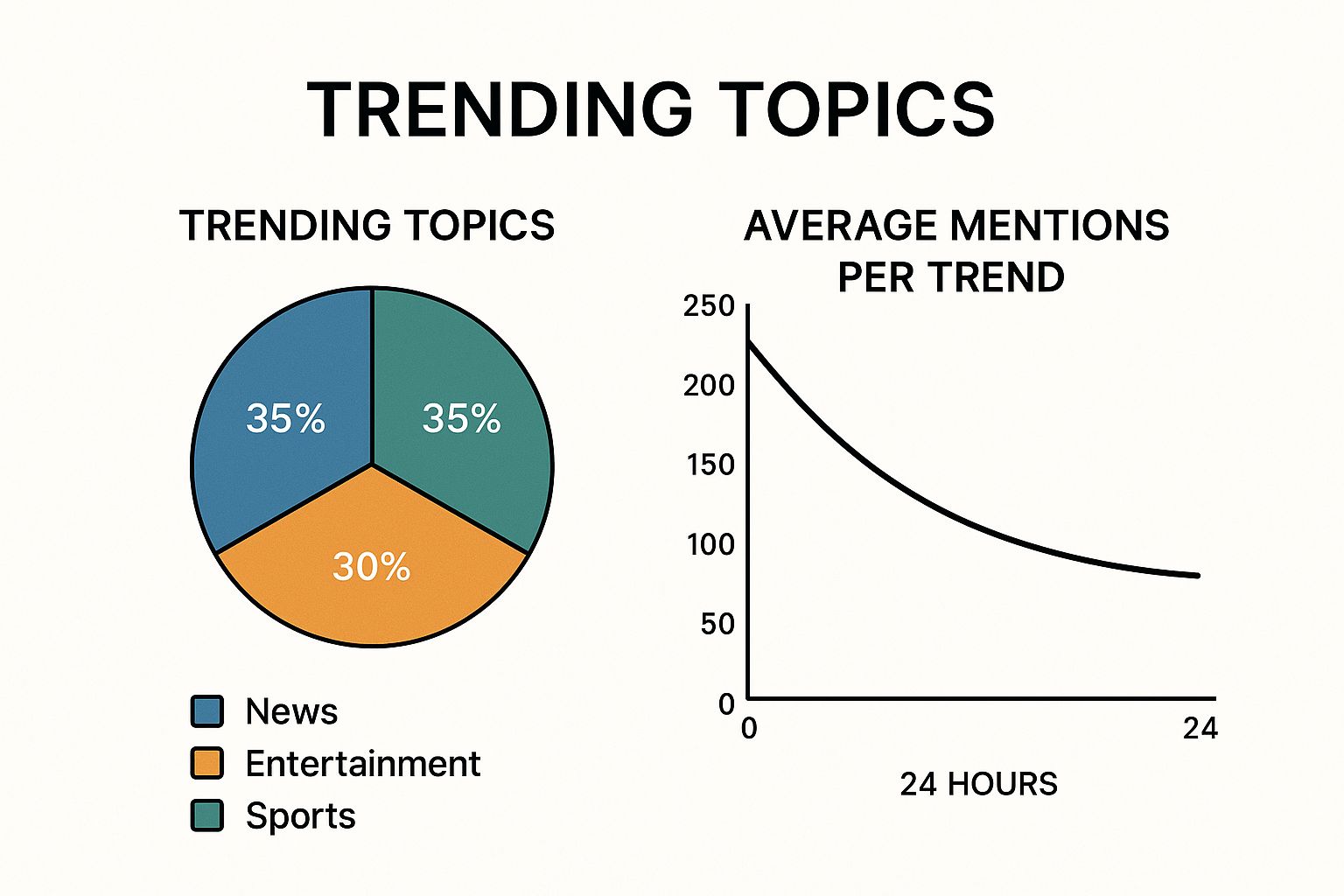Decoding Twitter's Trend Algorithm: What Really Makes Topics Trend
Understanding how Twitter's trend algorithm works is vital for anyone looking to identify trending topics. It's not just about seeing what's popular; it's about understanding the why behind a topic's rise. The algorithm considers several key factors, primarily velocity, volume, and novelty. Velocity refers to how quickly a topic is being discussed. A sudden surge in tweets about a specific subject alerts the algorithm to something noteworthy.
This brings us to the next factor: volume. A high number of tweets, retweets, likes, and replies contributes significantly to a topic's trending potential. However, volume alone isn't enough. Twitter also prioritizes novelty. Fresh, emerging topics are more likely to trend than ongoing discussions.
Understanding the Importance of Velocity, Volume, and Novelty
These three factors—velocity, volume, and novelty—work in concert to determine trending topics on Twitter. Think of it as a recipe: you need the right balance of each ingredient for the perfect outcome. A topic might have high velocity but low volume, suggesting a brief burst of interest that quickly fades.
Conversely, a topic with high volume but low velocity could represent an ongoing discussion that isn't necessarily trending upwards. Furthermore, Twitter's algorithm personalizes trends based on your interests and who you follow. This means what trends for you might not trend for someone else.
This personalization makes it important to understand broader trends beyond your own personalized feed. Statistically, Twitter trends are often dominated by entertainment and sports. These categories tend to generate high engagement and rapid information sharing. Currently, names like Beyoncé and sports teams like the Warriors and Rockets frequently appear in trending lists.
This is due to their large fan bases and the regular news coverage they receive. This aligns with Twitter's real-time nature, where live events like concerts or sports games can create enormous spikes in engagement within short timeframes. Analyzing these trends can offer insights into how specific topics gain widespread attention.
It also helps to understand how those topics correlate with broader cultural interests. Tools like Google Trends and Twitter's internal analytics can provide deeper insights into the searches and discussions surrounding these trending topics. For more detailed statistics, visit: https://us.trend-calendar.com
Organic vs. Promoted Trends
Finally, it's important to distinguish between organic trends and promoted trends. Organic trends emerge naturally from user activity, while promoted trends are paid advertisements. Understanding the difference helps you discern what genuinely resonates with the Twitter audience and what is simply being amplified by marketing spend. You might also be interested in learning more about Twitter analytics: How to master Twitter analytics and understand engagement metrics. By understanding the nuances of Twitter's trend algorithm, you can better navigate the platform and potentially leverage trending topics for your own purposes.
Mastering Twitter's Built-In Trend Discovery Tools
Beyond simply browsing trending topics, effectively using Twitter's features is crucial for trend discovery. This involves a strategic approach, utilizing Twitter's tools to find relevant trends within your specific niche.
Customizing Your Explore Tab For Targeted Trend Discovery
One of the most powerful, yet often underutilized, tools is the Explore tab. This tab is dynamic and can be personalized. By interacting with tweets and accounts in your niche, you inform Twitter's algorithm about your interests. This results in an Explore tab populated with relevant trends. For example, consistent engagement with marketing tweets will yield more marketing-related trends. You can further refine this by following relevant hashtags and accounts.
Unlocking The Power of Search Operators
Another key technique uses Twitter search operators. These operators enable precise filtering of conversations. Combining keywords, hashtags, and operators like "near," "since," and "until" uncovers niche trends otherwise hidden beneath broader topics. Imagine managing social media for a fashion brand. Search operators can pinpoint trending conversations about specific styles or designers, enabling targeted content creation.
Interpreting Twitter's Trend Categorization System
Effective social media managers understand Twitter's trend categorization. The platform uses sections like "For You," "Trending," "News," "Sports," and "Entertainment" to filter trends by subject. Savvy trend spotters go further, analyzing how trends move between categories and identifying emerging patterns. This reveals how trends evolve and which have sustained momentum. A topic starting in "News" and moving to "For You" suggests broader appeal and wider engagement potential. Finding trending topics on Twitter can be aided by historical data analysis. Tools like the Twitter Advanced Search feature allow exploration of past tweets, enabling analysis of trend evolution. Learn more about historical trend analysis: https://www.tweetbinder.com/blog/twitter-historical-data/
Algorithmic Vs. Chronological Trend Identification
Finally, understanding the difference between algorithmic and chronological trends is important. The default trending topics are algorithmically generated. Switching to a chronological view reveals the unfiltered conversation flow. This helps spot emerging trends before the algorithm identifies them. Building a personal trend monitoring system using both views, combined with the image below showcasing different Twitter feeds, provides the necessary tools for finding relevant trending topics.

Beyond Twitter: Third-Party Tools That Uncover Hidden Trends
While Twitter's native trending features offer a good starting point for discovering popular topics, using third-party tools can provide a significant advantage. These specialized platforms offer deeper insights and more focused trend identification, helping you uncover hidden gems you might miss on Twitter's general trending page.
Real-Time Monitoring and Hashtag Analysis
Tools like TweetDeck allow for real-time monitoring of specific keywords and hashtags. This is invaluable for staying on top of developing trends as they happen. Imagine you're tracking a product launch. TweetDeck can instantly alert you to spikes in conversation around relevant hashtags, enabling you to engage immediately.
TweetDeck also integrates well with other Twitter management tools.
Additionally, Hashtagify offers comprehensive hashtag analysis, providing data on hashtag popularity, related hashtags, and influencer engagement. This detailed information helps you choose the most effective hashtags for your content, maximizing reach and relevance. Check out our guide on manual vs. automated Twitter engagement for a deeper dive into optimizing your interactions on the platform.
Hashtagify is a freemium tool meaning some features are restricted unless you upgrade to a paid plan.
Visualizing Geographic Trends
Another powerful tool, Trendsmap, visualizes trends geographically. This reveals regional variations in trending topics, highlighting potential opportunities within specific locations. For example, a restaurant chain could use Trendsmap to see which food-related hashtags are trending in different cities, allowing for targeted local promotions.
Trendsmap offers various subscription levels, each providing access to different data and analysis features.
This level of granularity is often unavailable through Twitter alone. These third-party tools help uncover valuable micro-trends within your niche, revealing topics that might not reach the scale required for general trending status but are highly relevant to your specific audience.
Utilizing tools like Twitter Trending Archive and Trend Calendar can offer a structured approach to identifying trending topics. These platforms provide archives of past trends, allowing users to study how certain hashtags or topics have trended over time.
For example, by examining past trending lists, one can observe seasonal trends or significant events that influenced public discourse. Analyzing these patterns can help predict when specific types of content are likely to become popular again. Furthermore, understanding these historical trends can aid in crafting more engaging content by aligning with popular themes and keywords, potentially leading to higher visibility on the platform. Explore this topic further: https://archive.twitter-trending.com

Building Custom Dashboards
Many of these platforms allow for the creation of custom dashboards. These dashboards can be tailored to monitor specific keywords, hashtags, and even competitor activity. This level of customization creates a highly effective trend monitoring system focused precisely on what matters most to your brand or business. You can build a dashboard that tracks industry-specific keywords, competitor mentions, and relevant hashtags, all in one central location.
The following table summarizes some of the key features and capabilities of popular Twitter trend analysis tools:
Top Twitter Trend Analysis Tools Comparison: A comprehensive comparison of the most effective third-party tools for finding and analyzing Twitter trends.
| Tool Name | Key Features | Price | Best For | Limitations |
|---|---|---|---|---|
| TweetDeck | Real-time monitoring, multiple account management, scheduling | Free | Social media managers, journalists | Limited analytics |
| Hashtagify | Hashtag tracking, influencer identification, performance analysis | Freemium | Marketers, content creators | Advanced features require paid subscription |
| Trendsmap | Geographic trend visualization, real-time trend tracking, historical data | Paid | Businesses, researchers | Cost can be a barrier for small users |
| Brand24 | Brand monitoring, social listening, sentiment analysis | Paid | Businesses, PR agencies | Can be complex for new users |
Key takeaway: Choosing the right tool depends on your specific needs and budget. Consider factors like real-time monitoring, analytics depth, and geographic visualization when making your decision.
Translating Insights into Strategic Content Decisions
By leveraging the data and insights from these third-party tools, you can make strategic content decisions that align with current trends and audience interests. This results in more engaging content that resonates with your target audience and maximizes the impact of your social media efforts.
For instance, if you notice a trending hashtag relevant to your industry, you can quickly create content that incorporates that hashtag, increasing visibility and engagement. These insights can even influence product development or marketing campaigns, aligning your business strategies with real-time audience interests. This proactive approach, fueled by accurate trend data, sets you apart from competitors who rely solely on reactive engagement.
Mining Historical Twitter Trends for Strategic Advantage

The past offers valuable lessons, especially regarding social media trends. Understanding historical Twitter data is crucial for any social media strategist. It's about more than just reviewing old tweets; it's about identifying patterns and cycles that can inform future content strategies.
Using Twitter's Advanced Search to Analyze Past Trends
Twitter's Advanced Search is a powerful tool for mining historical trends. It lets you specify date ranges, keywords, hashtags, and even specific accounts to analyze past conversations.
For example, analyze how a specific hashtag performed during a previous product launch or marketing campaign. This reveals valuable insights into audience engagement and sentiment.
Analyzing past trend cycles can also identify recurring patterns that signal upcoming opportunities. Certain trends, like seasonal topics or annual events, often follow predictable patterns. Recognizing these patterns allows you to prepare content in advance.
Categorizing Historical Trends and Spotting Similarities
A framework for categorizing historical trends is vital for identifying similarities with current viral content. Group past trends by topic, event, or even sentiment. This organization helps spot recurring themes and predict how current conversations might evolve.
For instance, if a current viral topic resembles a past trend, use the historical data to anticipate its trajectory and longevity. This allows for strategic messaging, getting ahead of anticipated conversation waves.
Building an Actionable Trend Calendar
Leverage historical data to build an actionable trend calendar. This calendar can include recurring events, seasonal topics, and even predicted trend revivals. This proactive approach ensures you're always prepared to engage with relevant conversations.
Consider how holidays or annual industry conferences consistently generate trending topics. By including these in your trend calendar, you can plan content and campaigns well in advance.
Understanding past engagement metrics, such as retweets, likes, and replies, helps forecast the potential reach and impact of future content. This data-driven approach increases the likelihood of content resonating with your target audience.
Interpreting Engagement Metrics from Past Trends
Don't just look at what trended; analyze how it trended. Examining past engagement metrics provides crucial information for predicting future performance.
Did a particular hashtag generate high retweet rates? Did certain types of content receive more replies? These insights inform your current content strategy. By understanding past engagement, you can tailor your content to maximize its potential for viral spread. This transforms how you find trending topics, turning reactive observation into proactive engagement.
Creating Content That Captures Trending Conversations
Finding trending topics on Twitter is just the first step. The real work begins when crafting content that effectively uses these trends. Simply adding a trending hashtag isn't enough. You need content that genuinely contributes to the ongoing discussion. This involves understanding your brand's unique voice, knowing your target audience, and strategically choosing which trends to engage with.
Aligning Trends With Your Brand and Audience
Not every trending topic suits every brand. It's essential to determine if a specific trend aligns with your brand's voice and resonates with your audience. For instance, a humorous brand might leverage a trending meme, while a more serious brand might focus on a news-related trend. Jumping on an unsuitable trend can seem forced and inauthentic, potentially alienating your audience.
Also, consider your audience's expectations. What interests them? What kind of content do they usually engage with? Understanding your audience helps you select trends relevant to their interests and values. This ensures your content feels natural and adds meaningfully to the conversation.
Balancing Trend Relevance and Brand Authenticity
Maintaining a balance between leveraging a trend's popularity and preserving your brand's authenticity is crucial. While timeliness and relevance are important, staying true to your brand's identity is equally vital. Don't force a connection where one doesn't exist. Instead, seek out trends that naturally align with your brand's values and messaging. This will make your content feel genuine and avoid the impression of opportunistic trend-hopping.
Assessing Trend Potential and Crafting Standout Content
Before engaging with a trend, evaluate its potential. Is it a short-lived fad or a topic with lasting relevance? Think about the trend's lifecycle. Is it emerging, peaking, or already declining? Understanding a trend's trajectory allows you to time your content for maximum visibility and impact. For further insights, check out this helpful resource: How to master engaging with trending tweets.
Once you've found a suitable trend, concentrate on creating content that stands out. In a busy online space, your content must capture attention and offer value. This can be achieved through insightful commentary, creative visuals, or a unique perspective. Focus on adding to the conversation, not just repeating what others are saying.
Timing Your Content for Maximum Visibility
Timing is key when it comes to trending topics. Too early, and your content might get lost. Too late, and the opportunity might be gone. The aim is to engage when the trend is at its peak, maximizing visibility and engagement. This requires careful monitoring of trends and the ability to produce content quickly and effectively.
Spotting Tomorrow's Twitter Trends Before They Explode
Identifying trends before they take off is like having a crystal ball for social media. This foresight gives you a competitive edge, allowing you to create timely content that captures attention and drives engagement. But how do you achieve this predictive power? By mastering the art of trend forecasting. This involves understanding the catalysts behind viral moments, recognizing patterns in online conversations, and building a network that keeps you informed.
Understanding how trends emerge and spread is key to this process. To help visualize this, let’s look at the lifecycle of a typical Twitter trend, as represented in the data chart below. This chart visualizes the relative volume of tweets over time, showing the distinct stages of a trend's lifespan.

As you can see, identifying trends early, in the growth phase, is crucial for maximizing engagement.
Identifying Trend Catalysts: The Spark Before the Fire
Just as a single match can ignite a bonfire, specific catalysts often precede wider trends on Twitter. Recognizing these early indicators can help you anticipate what’s about to go viral. These catalysts can include breaking news events, emerging viral content (like a new meme or challenge), and changes in influencer behavior.
For example, if several key influencers in a specific industry start tweeting about a particular product, it could signal a surge in broader interest. A sudden increase in tweets using a particular hashtag might indicate a developing news story or a viral challenge taking hold.
Pattern Recognition: Spotting the Ripple Effect
Another key element of trend forecasting is recognizing patterns in conversation velocity. This means noticing when conversations within niche communities begin to accelerate before they reach wider audiences. Think of it as a ripple effect. A small wave, barely noticeable initially, can grow as it spreads outwards.
This is similar to how trends emerge on Twitter. By monitoring specific keywords and hashtags within your area of interest, you can detect these early ripples of increased conversation. This often requires tools beyond Twitter's standard features.
Building Your Trend-Setter Network
Creating a network of trend-setting accounts whose content consistently precedes wider movements is invaluable. These accounts are like your personal trend radar, providing early signals of what’s about to become popular.
By following these accounts closely and observing their engagement, you can gain a sense of emerging trends before they hit the mainstream. It's like having a team of scouts constantly looking for signs of change.
Sentiment Analysis and Notification Systems
Measuring potential trend momentum is vital for effective forecasting. Sentiment analysis helps gauge public opinion around emerging trends. Is the sentiment positive, negative, or mixed? This understanding lets you assess the likelihood of widespread growth.
Setting up notification systems for unusual activity around your chosen keywords is also essential. These alerts act as an early warning system, notifying you of spikes in conversation or engagement. This lets you react quickly and create relevant content.
To further break down the lifecycle of a Twitter trend and the strategies you can employ, let's look at a table summarizing key information. This table outlines the different phases of a trend and how best to engage with each.
Twitter Trend Lifecycle Stages Understanding the different phases of a Twitter trend and the optimal strategies for each stage
| Trend Stage | Identifying Characteristics | Engagement Opportunity | Content Strategy | Risk Level |
|---|---|---|---|---|
| Inception | Low tweet volume, limited visibility | Early adopter advantage | Original, unique content | High |
| Growth | Rapidly increasing tweet volume, growing visibility | Ride the wave | Relevant, engaging content | Medium |
| Peak | Highest tweet volume, maximum visibility | Join the conversation | Timely, reactive content | Low |
| Waning | Decreasing tweet volume, declining visibility | Offer new perspectives | Thoughtful, analytical content | Medium |
| Decline | Low tweet volume, minimal visibility | Retrospective analysis | Summarizing, concluding content | Low |
This table highlights the importance of adapting your content strategy to the specific stage of a trend's lifecycle. Understanding these stages and acting accordingly can greatly increase your chances of success.
Ready to improve your engagement? Reply Guy helps you identify trending tweets, enabling timely interaction. With customizable filters, AI-powered strategy, and a streamlined workflow, Reply Guy helps you engage more efficiently. Start growing your Twitter following with Reply Guy.
Article created using Outrank
